
Guests
- Johanna Fernándezassociate professor of history at the City University of New York’s Baruch College and guest curator for the Smithsonian’s National Museum of the American Latino.
- Felipe Hinojosahistory professor at Baylor University in Texas and guest curator for the Smithsonian’s National Museum of the American Latino.
A political battle is brewing in Washington, D.C., over plans to build a National Museum of the American Latino and the portrayal of American Latino history. Last year, the Smithsonian Institution opened a temporary preview exhibition inside the National Museum of American History that has become the focus of controversy within the Latino community, as Republican lawmakers and others challenge what one conservative writer described in The Hill as an “unabashedly Marxist portrayal of history.” We speak to two historians who were hired to develop a now-shelved exhibit on the Latino civil rights movement of the 1960s for the museum. Felipe Hinojosa is a history professor at Baylor University in Texas, and Johanna Fernández is an associate professor of history at the City University of New York’s Baruch College. We discuss their vision for the first national museum dedicated to Latino history, which Hinojosa describes as “complex” and “nuanced,” and how conservative backlash has sought to stymie and rewrite their work. “These conservatives are using fear to essentially push through their agenda,” says Fernández, who warns that the rising wave of censorship throughout the U.S. could be a “repeat of the Red Scare.”
Transcript
AMY GOODMAN: This is Democracy Now!, democracynow.org, The War and Peace Report. I’m Amy Goodman, with Juan González.
We turn now to look at a brewing controversy at the Smithsonian Institution over plans to build a National Museum of the American Latino. In 2020, Congress passed funding to create the museum, along with an American Women’s History Museum, but there’s been a deep divide in Washington over how Latinos should be portrayed in the museum. Last year, the museum opened a temporary exhibit inside the Smithsonian’s National Museum of American History. The exhibition is called “¡Presente! A Latino History of the United States.” Republican lawmakers and other conservatives within the Latino community have attacked the exhibition, leading the Smithsonian to halt plans for a future exhibition on the Latino civil rights movement of the 1960s. In its place, the Smithsonian is now planning an exhibition on salsa and Latin music. This fight is exploding into public view in the midst of National Hispanic Heritage Month, which runs from September 15th to October 15th.
This is Jorge Zamanillo, the founding director of the National Museum of the American Latino, giving a brief tour of the current exhibit in a video posted by the Smithsonian.
JORGE ZAMANILLO: Well, Latino history is American history. And to tell that full story and to tell that full history, we have to acknowledge our colonial past. So, here, we feature a portrait of Popé, the sculpture. He’s a Tewa leader, organized the Pueblo Revolt of 1680. We feature Toypurina, who was a medicine woman. That was a post-colonial rule. So these are important stories to feature and highlight how important they are in shaping our future. And these communities were around for hundreds of years before European colonization. So that’s important on how that led to shaping our history. …
Lulu, in “¡Presente!,” we further explore how racism and colorism developed during the colonial period. And we have a few examples from Puerto Rico that illustrate this point for visitors. This 1973 poster by Augusto Marín emphasizes that role of Black Puerto Ricans in the abolition of slavery on their island in 1873. We can also find deep historical meaning in Latino music and dance traditions. This outfit belonged to Tata Cepeda, an icon of Puerto Rican Bomba music. Bomba is a family of rhythms and dances with African and Caribbean roots that has historically offered Black Puerto Ricans a space for creative resistance and renewal.
Bringing it back to today, here’s a great photo by Joaquin Medina documenting the Black Lives Matter movement in Puerto Rico. For us at the museum, “Latino” is a label that brings together racially and regionally diverse communities. Representing both our commonalities and our differences is a core part of our work.
AMY GOODMAN: That was Jorge Zamanillo, the founding director of the National Museum of the American Latino.
One vocal critic of the museum’s exhibition has been the Cuban-born Congressmember Mario Díaz-Balart, who threatened in July to block funding for the museum — he serves on the House Committee on Appropriations — and later backed down on his threat after he met with Jorge Zamanillo and Lonnie Bunch, the secretary of the overall Smithsonian Institution. After the meeting, the museum changed parts of the exhibit featuring a foam raft used by Cuban refugees to flee the country. The original exhibition text said the refugees were, quote, “escaping Cuba’s economic crisis.” In July, the text was changed to add a reference to Fidel Castro and, quote, “Cuba’s dictatorship, political repression, and economic crisis,” unquote. Some of the first public criticism of the current exhibition came from a group of conservative writers who penned a column in The Hill last year claiming the exhibit offered a, quote, “unabashedly Marxist portrayal of history,” unquote.
The controversy comes as the Smithsonian is seeking to raise enough money to build the museum, which will cost an estimated $800 million. The New York Times reports $58 million has been raised so far.
We’re joined now by two historians who have been hired to develop the now-shelved exhibit on the Latino civil rights movement of the '60s for the museum. Felipe Hinojosa is a history professor at Baylor University in Texas. He's also the author of the book Apostles of Change: Latino Radical Politics, Church Occupations, and the Fight to Save the Barrio. Johanna Fernández is an associate professor of history at the City University of New York’s Baruch College. She’s also the author of The Young Lords: A Radical History of the United States.
We welcome you both to Democracy Now! Johanna Fernández, let’s begin with you. What has happened? I mean, the idea that this museum was going to be built either across the Mall from the Museum of African American History or in the Tidal Basin, but this, your “¡Presente!” exhibit, has led to this kind of uprising on the right. Can you explain what the current exhibit is, what the one that has been shelved is, at least for now, that you and Professor Hinojosa have been the creators of?
JOHANNA FERNÁNDEZ: “¡Presente!” — well, thank you for covering this evolving crisis. “¡Presente!” is the current exhibition at the Molina Family Gallery within the American History Museum at the Smithsonian. It’s an exhibition in waiting while the actual building of the Latino History Museum goes up in 10 to 12 years.
What is important about “¡Presente!” is that it really outlines the contours of Latino history, which are complicated. One of the points it makes is that the largest Latino population in the United States was integrated after the United States war with Mexico in 1848, which is responsible for giving the United States its contemporary boundaries. Half of the United States was acquired during that war, and the people who were in those Mexican lands remained in the now borders of the United States. And the integration of those people into a hostile America is part of American history. The “¡Presente!” exhibition also highlights the acquisition by the United States of Puerto Rico in 1898 and also discusses the ways in which U.S. foreign policy and economic policy has driven people out of Latin America and into the United States. So, what’s important is that it establishes the question: Who are Latinos? How did they get here? And what’s their relationship to their communities and to the nation and the world?
Unfortunately, conservative Latinos don’t want to hear that narrative. They want a narrative that emphasizes Latino military service and business success among Latinos in the United States.
JUAN GONZÁLEZ: And, Professor Felipe Hinojosa, you come from — you work and come from Texas, a state at the forefront of some of the culture wars that we’re experiencing today. Could you talk about how you learned of the concern here, and what you were told by folks at the Smithsonian about what needed to change or didn’t need to change in terms of the work you were doing?
FELIPE HINOJOSA: Well, thank you, first off, for having me.
Yes, I am from Texas. I’m from the Rio Grande Valley, born and raised in Brownsville, Texas. That has shaped a big part of who I am. It shapes a big part of the work that I do.
Writing about and teaching on the Latino civil rights movement has been a centerpiece of the work that I do and that I’ve collaborated with other historians in doing. And I think in joining with this work with the Smithsonian, I think, for me, the biggest joy and the biggest thrill was to be able to present these questions that Johanna has just mentioned. The larger and broader questions of who are we and who are we as a community and what is our relationship to the nation were central questions for Latino civil rights activists in the 1960s and 1970s.
We worked on this exhibit, on the “Latino Youth Movements” exhibit, with the Smithsonian for two years. We were 65% complete. And the sort of rumblings that started to happen came immediately after the piece that was published in The Hill. I believe it was summer of 2022 when that came out. And there was some concern in terms of the kind of material that we would be presenting. But I think, for us, our major concern was to just make sure that we were telling a truthful story, a complex story and a nuanced story about how Latinos have grappled with their relationship to the United States.
The critiques that came to us and what we were told in terms of what could be and could not be included, I think, were alarming to us. And when the email came in November of 2022 that this exhibit was going to be paused or canceled, I think it confirmed our fears of the fact that the Smithsonian was not viewing the Latino civil rights movement as a broad enough story, as a story that would raise the kind of funds that this museum needs to open in 10 or 12 years. And I think, from the work, certainly, that we have done and the work that we were engaged in for two years, nothing could be further than the truth. What’s bigger and what’s more, I think, central than young people asking themselves and their communities how they can make this a nation that is better for all?
JUAN GONZÁLEZ: And, Johanna Fernández, this whole issue of political leaders putting pressure on a museum to basically override the historians that the museum has chosen to develop its exhibitions?
JOHANNA FERNÁNDEZ: Well, I think we have to look at this conflict in the broader history of the last 10 years, when conservatives have launched a calculated and broad-sweeping campaign to essentially eliminate the teaching of Black American history, Latino history, ethnic studies, women’s history and LGBTQ+ history in the schools. And now what we see is that through this witch hunt and by smearing historians and curators as Marxists, these conservatives are using fear to essentially push through their agenda. And now, again, this has reached a federal museum, and not just any federal museum, but the largest network of museums in the world, which is known as the Smithsonian. In many ways, this sounds and looks like a repeat of the Red Scare or previous moments of repression in the United States.
AMY GOODMAN: So, Professor Fernández, what is your response to them sending you this email saying they’re putting your next exhibition on pause? To be clear, “¡Presente!” is now in that temporary National American History Museum space, and the one you’re doing on the civil rights movement is the one that is paused, saying that they want to appeal to a larger audience, especially because they’re fundraising, and so they’ll shelve the civil rights issue and do instead an exhibition on salsa music and Latin music.
JOHANNA FERNÁNDEZ: I think we have to say that there is no more integral matter in the United States than the struggle for freedom, democracy and to redefine the United States as a country for all. That’s integral and core to the American imagination. So, to say that this issue is a minor one is really to not understand the very essence of American history, upon which the American Revolution and its determination to fight for liberty and the pursuit of happiness is core.
JUAN GONZÁLEZ: And, Professor Hinojosa, I wanted to ask you, in terms of the — in Texas itself, there clearly is a very significant and strong conservative population in the Latino community. So, not only is this a national ethnic struggle, there’s also a class component to how people view history. What’s your sense of why it is so important to tell the story as you have researched it and looked into it throughout your career versus what some of the political leaders of your state might want?
FELIPE HINOJOSA: Well, first of all, I would say a lot of political leaders are often disconnected from the grassroots community. They don’t understand what the community is asking for. I’ve been in the classroom for over 20 years. Students are wanting more of this history, wanting to better understand how Latinos have shaped Texas politics, have shaped the history of the United States — and not just Latino students, by the way. I’m talking to students of all backgrounds that are very invested in telling a bigger story of American history and having a broader understanding of it.
The other thing is demographic change, the demographics of the state of Texas. Texas is now a Latino-majority state. And so, to have those demographic changes that have taken place in the last 20 years across the state, I think, signaled to us a tremendous responsibility to teach this history, to have a better understanding of the contributions of this community. We are not perpetual foreigners. We are not people that are new to this nation. We have contributed for generations to make this country what it is today, and in particular in my home state of Texas.
And the idea is not to simply talk about a liberal-versus-conservative idea of history. The idea here is to tell a story that is complex, that is nuanced and that gets at this idea of democracy, that gets at how different people from different sections of society have made this country what it is today, and I think in particular the state of Texas. I mean, there’s a reason why Texas history classes fill up the way that they do at universities across my home state of Texas. People love this history. They respect it. They admire it, as they should. But we need a bigger telling of it. We need a bigger story, a story that brings in marginalized voices, voices that have been silenced throughout history. And I think our exhibit was one small step to try to do that, not only at the state level, but at the national level.
JUAN GONZÁLEZ: And could you give, perhaps, some examples of [inaudible] that you wanted to put forth in the civil rights exhibit, especially in terms of Texas, a history that many Americans perhaps may not be aware of, whether it’s the Crystal City uprising in the early ’60s or other aspects of Texas Latino history?
FELIPE HINOJOSA: Yeah. In particular, we were looking at the ways in which Latinos in the state of Texas and across the Southwest and across the country have not waited for the nation to do something for us. We’re not sitting idly by. Historically, what we’ve done is we’ve taken matters into our own hands for political participation.
You mentioned Crystal City, in 1963 gaining ground to the Crystal City’s City Council. There was a group of five Mexican Americans that won those City Council seats. That was a huge, huge shift and, I think, a call to the state of Texas that Mexican Americans were serious about political participation. They went on to form La Raza Unida Party. They ran a candidate for a governor here in the state of Texas. And that’s the kind of history that we want to tell, one of agency, one of power, one that gets at how Latinos have not simply waited on but have acted upon to make this country more democratic and more representative for all.
AMY GOODMAN: Professor Hinojosa, we want to thank you for being with us, of Baylor University in Texas, and Johanna Fernández, professor of history at the City University of New York: Baruch College. And, Juan, thank you so much for your book, Harvest of Empire: Stories of Latinos in America. I’m Amy Goodman, with Juan González.

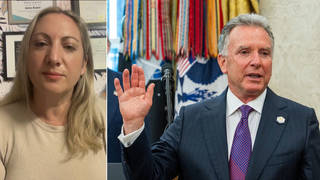
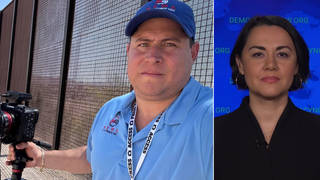
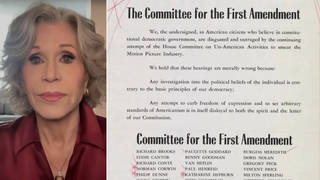



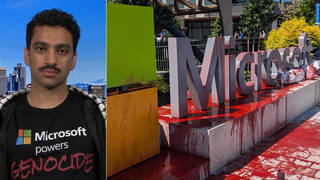
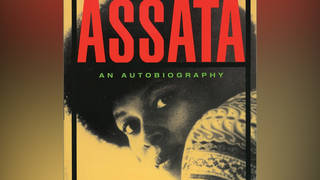

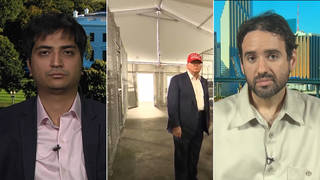
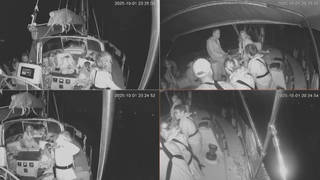
Media Options